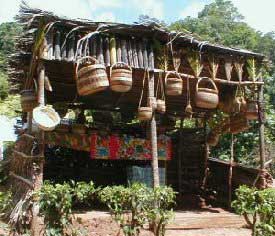 Dominica geography
Dominica geography
Dominica lies in the center of the Caribbean chain of
islands, between the French overseas territories of Guadeloupe and Martinique.
It is a rugged island noted for its mountains, rivers and waterfalls. It, more
than any other island in the Caribbean, has managed to retain its natural
beauty. Dominica is home to the second largest boiling lake in the world.
With an area of 298 square miles (751 sq km), it is the fourth largest island
in the English speaking Caribbean. At its longest, it is twenty-nine (29) miles
and at its widest, it is sixteen (16) miles. It has a population of 71,727 (2000
census) peopled mainly of African descent. There is also an increasing white and
Chinese population. Dominica is also home to the last Carib population in the
Caribbean.
There are two urban centers in Dominica - the capital of Roseau and the
second town of Portsmouth. Roseau is the administrative and commercial center
and has a population of 20 000 people. Portsmouth which is much more scenic has
a population of 5 000 people. About one thousand (1,000) of these are students
and staff (mostly Americans) of Ross University School of Medicine, an offshore
medical school.

 History
History
Dominica was discovered by Christopher Columbus in 1493 but most of its early
colonial history was spent changing hands between the French and the English.
Although the French finally lost control to the English in 1776, their influence
is still strong, principally through the French Creole language which most
islanders speak, the dominance of the Roman Catholic church and numerous place
names. Dominica became independent in 1978 and is a member of the British
Commonwealth.
It is also a member of the United Nations, Organisation of
American States (OAS), the Caribbean Community and a number of other regional
and international organisations. .( Read More Dominica History)
Political System
Dominica is a democratic country which has enjoyed universal adult sufferage
since the 1950's. It follows the Westminster model of Government. Elections are
held every five years to elect twenty-one (21) members of Parliament. Nine (9)
senators are then appointed and together they sit in a unicameral legislature.
The Head of State is a President who is elected by Parliament and holds office
for a term of five years. His role is essentially ceremonial. The current Prime
Minister is the Honourable Roosevelt Skeritt who was elected in May 2005.
There are three (3) main political parties in Dominica. They are the United
Workers Party (UWP), the Dominica Freedom Party (DFP) and the Dominica Labour Party (DLP). The
present government is the Dominica Labour Party.
Since Independence in 1978, there has been seven Prime Ministers: Patrick John (1978 - 79 DLP); Oliver Seraphin (1979 - 80 DLP);Mary Eugenia Charles (1980 - 1995 DFP);Edison James (1995 - 2000 UWP);Roosevelt Douglas (Feb - Oct 2000 DLP); Pierre Charles (2000 - 04 DLP) ; and Roosevelt Skeritt (2004 - Present DLP). Both Douglas and Charles died in office while John was forced to resign. The President is His
Excellency Mr. Nicholas Liverpool who was elected in 2003.

Judicial System
Dominica enjoys an independent judiciary with its highest court being the
Judicial Committee of the Privy Council in London. At the lowest rung of the
judiciary is the Magistrate Court which deals with minor civil and criminal
matters. Then there is the High Court which handles serious civil and criminal
cases. Appeals from both the High Court and the Magistrate Court go to the Court
of Appeal. Dominica shares a Court of Appeal with other members of the
Organisation of Eastern Caribbean States. That court is a circuit court which
sits in each island two or three times a year. Appeals from the Eastern
Caribbean Court of Appeal go to the Judicial Committee of the Privy Council.
Dominica has an English common law legal system and most of its statute law
is based on United Kingdom precedents. There are about 50 practicing lawyers in
Dominica.

Economy
 Dominica's economy is substantially based on agriculture,
although in recent years great strides have been made on diversification into
tourism and offshore services. Bananas is Dominica's principal export and it
contributes about 80 percent of Gross Development Product (GDP). Dominica's
traditional market for its bananas is the United Kingdom where its exports,
along with those of the other Windward Islands, enjoy preferential treatment.
Recently, however, the preferential treatment of Dominica and other African
Caribbean and Pacific (ACP) bananas has been under attack and has been subject
of adverse decisions in the Word Trade Organisation (WTO). This has cast a dark
shadow over the continued existence of Dominica's banana industry in its
traditional form.
Dominica's economy is substantially based on agriculture,
although in recent years great strides have been made on diversification into
tourism and offshore services. Bananas is Dominica's principal export and it
contributes about 80 percent of Gross Development Product (GDP). Dominica's
traditional market for its bananas is the United Kingdom where its exports,
along with those of the other Windward Islands, enjoy preferential treatment.
Recently, however, the preferential treatment of Dominica and other African
Caribbean and Pacific (ACP) bananas has been under attack and has been subject
of adverse decisions in the Word Trade Organisation (WTO). This has cast a dark
shadow over the continued existence of Dominica's banana industry in its
traditional form.

Telecommunications
Dominica has a very modern telecommunication system. Indeed, it holds the
position in the Guiness Book of World Records as being the first country in the
world to establish a fully digital system. The telecommunications providers are
Cable & Wireless (Dominica) Ltd., Orange Telecoms, Digicel, SAT Telecoms and Marpin Telecoms and Broadcasting Ltd.
